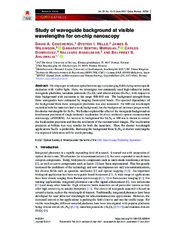Study of waveguide background at visible wavelengths for on-chip nanoscopy
Permanent link
https://hdl.handle.net/10037/22714Date
2021-06-17Type
Journal articleTidsskriftartikkel
Peer reviewed
Author
Coucheron, David Andre; Helle, Øystein I.; Wilkinson, James S.; Murugan, Ganapathy Senthil; Domínguez, Carlos; Angelskår, Hallvard; Ahluwalia, Balpreet S.Abstract
On-chip super-resolution optical microscopy is an emerging field relying on waveguide excitation with visible light. Here, we investigate two commonly used high-refractive index waveguide platforms, tantalum pentoxide (Ta2O5) and silicon nitride (Si3N4), with respect to their background with excitation in the range 488–640 nm. The background strength from these waveguides were estimated by imaging fluorescent beads. The spectral dependence of the background from these waveguide platforms was also measured. For 640 nm wavelength excitation both the materials had a weak background, but the background increases progressively for shorter wavelengths for Si3N4. We further explored the effect of the waveguide background on localization precision of single molecule localization for direct stochastic optical reconstruction microscopy (dSTORM). An increase in background for Si3N4 at 488 nm is shown to reduce the localization precision and thus the resolution of the reconstructed images. The localization precision at 640nm was very similar for both the materials. Thus, for shorter wavelength applications Ta2O5 is preferable. Reducing the background from Si3N4 at shorter wavelengths via improved fabrication will be worth pursuing.
Publisher
Optical Society of AmericaCitation
Coucheron DA, HELLE, Wilkinson, MURUGAN, DOMINGUEZ, Angelskår, AHLUWALIA. Study of waveguide background at visible wavelengths for on-chip nanoscopy. Optics Express. 2021;29(13):20735-20746Metadata
Show full item recordCollections
Copyright 2021 The Author(s)


 English
English norsk
norsk